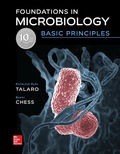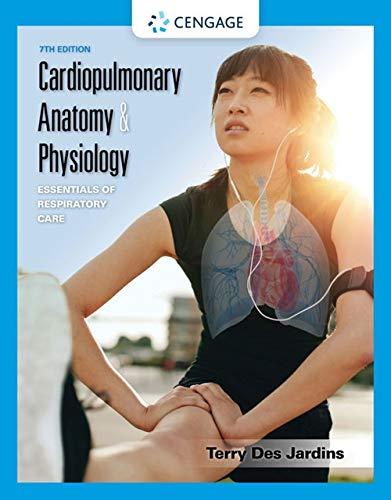
EBK FOUNDATIONS IN MICROBIOLOGY: BASIC
10th Edition
ISBN: 9781259916045
Author: TALARO
Publisher: MCGRAW HILL BOOK COMPANY
expand_more
expand_more
format_list_bulleted
Textbook Question
Chapter 2.3, Problem 15ELO
15. Describe the scale and how it was derived; define acid, base, and neutral levels.
Expert Solution & Answer
Want to see the full answer?
Check out a sample textbook solution
Students have asked these similar questions
Which microbe does not live part of its lifecycle outside humans?
A. Toxoplasma gondii
B. Cytomegalovirus
C. Francisella tularensis
D. Plasmodium falciparum
explain your answer thoroughly.
Select all of the following that the ablation (knockout) or ectopoic expression (gain of function) of Hox can contribute to.
Another set of wings in the fruit fly, duplication of fingernails, ectopic ears in mice, excess feathers in duck/quail chimeras, and homeosis of segment 2 to jaw in Hox2a mutants
Select all of the following that changes in the MC1R gene can lead to:
Changes in spots/stripes in lizards, changes in coat coloration in mice, ectopic ear formation in Siberian hamsters, and red hair in humans
Chapter 2 Solutions
EBK FOUNDATIONS IN MICROBIOLOGY: BASIC
Ch. 2.1 - Prob. 1ELOCh. 2.1 - Prob. 2ELOCh. 2.1 - Prob. 3ELOCh. 2.1 - Prob. 4ELOCh. 2.1 - Prob. 5ELOCh. 2.1 - Prob. 1CYPCh. 2.1 - Prob. 2CYPCh. 2.1 - Prob. 3CYPCh. 2.1 - Prob. 4CYPCh. 2.1 - Prob. 5CYP
Ch. 2.1 - Prob. 6CYPCh. 2.2 - Prob. 6ELOCh. 2.2 - Prob. 7ELOCh. 2.2 - Prob. 8ELOCh. 2.2 - Prob. 9ELOCh. 2.2 - Prob. 10ELOCh. 2.2 - Prob. 11ELOCh. 2.2 - 7. Explain how the concepti of molecules and...Ch. 2.2 - Prob. 8CYPCh. 2.2 - Prob. 9CYPCh. 2.2 - Prob. 10CYPCh. 2.2 - Prob. 11CYPCh. 2.2 - Prob. 12CYPCh. 2.2 - Prob. 13CYPCh. 2.2 - Prob. 14CYPCh. 2.3 - Prob. 12ELOCh. 2.3 - 13. Explain solutes, solvents, and hydration.Ch. 2.3 - Prob. 14ELOCh. 2.3 - 15. Describe the pH scale and how it was derived;...Ch. 2.3 - Prob. 15CYPCh. 2.3 - Prob. 16CYPCh. 2.3 - 17. What properties of water make it an effective...Ch. 2.3 - Prob. 18CYPCh. 2.3 - 19. What determines whether a substance is an acid...Ch. 2.4 - 16. Describe the chemistry of carbon and the...Ch. 2.4 - Prob. 17ELOCh. 2.4 - Prob. 18ELOCh. 2.4 - Prob. 20CYPCh. 2.4 - Prob. 21CYPCh. 2.4 - Prob. 22CYPCh. 2.4 - 23. What are functional groups?Ch. 2.4 - Prob. 24CYPCh. 2.5 - 19. Define carbohydrate and know the functional...Ch. 2.5 - Prob. 20ELOCh. 2.5 - 21. Discuss the functions of carbohydrates in...Ch. 2.5 - Prob. 25CYPCh. 2.5 - Prob. 26CYPCh. 2.5 - 27. What are some of the functions of...Ch. 2.6 - 22. Define lipid, triglyceride, phospholipid,...Ch. 2.6 - 23. Describe how an ester bond is formed.Ch. 2.6 - Prob. 24ELOCh. 2.6 - 28. Draw simple structural molecules of...Ch. 2.7 - 25. Describe the structures of peptides and...Ch. 2.7 - 26. Characterize the four levels of protein...Ch. 2.7 - 27. Summarize some of the essential functions of...Ch. 2.7 - Prob. 29CYPCh. 2.7 - 30. Differentiate between a peptide, a...Ch. 2.7 - 31. Explain what causes the various levels of...Ch. 2.7 - 32. What functions do proteins perform in a cell?Ch. 2.8 - 28. Identify a nucleic acid and differentiate...Ch. 2.8 - Prob. 29ELOCh. 2.8 - 30. Explain how the DNA code may be copied, and...Ch. 2.8 - 33. Describe a nucleotide and a polynucleotide,...Ch. 2.8 - 34. Name the two purines and the three...Ch. 2.8 - 35. What are the functions of RNA?Ch. 2.8 - 36.What is ATP, and how does it function in cells?Ch. 2.L1 - 1. The smallest unit of matter with unique...Ch. 2.L1 - 2. The charge of a proton is exactly balanced by...Ch. 2.L1 - Prob. 3MCQCh. 2.L1 - Prob. 4MCQCh. 2.L1 - Prob. 5MCQCh. 2.L1 - Prob. 6MCQCh. 2.L1 - Prob. 7MCQCh. 2.L1 - 8. An atom that can donate electrons during a...Ch. 2.L1 - 9. In a solution of NaCl and water, NaCl is the...Ch. 2.L1 - 10. A solution with a pH of 2 than a solution with...Ch. 2.L1 - 11. Fructose is a type of a. disaccharide b....Ch. 2.L1 - 6. Bonds in which atoms share electrons are...Ch. 2.L1 - 13. How is our understanding of microbiology...Ch. 2.L1 - 14. A phospholipid contains a. three fatty acids...Ch. 2.L1 - 15. Proteins are synthesized by linking amino...Ch. 2.L1 - 16. The amino acid that accounts for disulfide...Ch. 2.L1 - 17. DNA is a hereditary molecule that is composed...Ch. 2.L1 - 18. What is meant by the term DMA replication? a....Ch. 2.L1 - 19. Proteins can function as a. enzymes b....Ch. 2.L1 - 20. RNA plays an important role in what biological...Ch. 2.L1 - 1. Which of the following has not been a major...Ch. 2.L1 - 2. What was a significant result of the Mars...Ch. 2.L1 - Prob. 3CSRCh. 2.L1 - Prob. 1WCCh. 2.L1 - Prob. 2WCCh. 2.L1 - Prob. 3WCCh. 2.L1 - Prob. 4WCCh. 2.L1 - Prob. 5WCCh. 2.L1 - 6. Why are hydrogen bonds relatively weak?Ch. 2.L1 - 7. What kind of substances will be expected to be...Ch. 2.L1 - Prob. 8WCCh. 2.L1 - Prob. 9WCCh. 2.L1 - 10. What makes the amino acids distinctive, and...Ch. 2.L1 - Prob. 11WCCh. 2.L1 - Prob. 12WCCh. 2.L1 - 6. Bonds in which atoms share electrons are...Ch. 2.L2 - Prob. 1CTCh. 2.L2 - Prob. 2CTCh. 2.L2 - Prob. 3CTCh. 2.L2 - 4. Distinguish between polar and ionic compounds.Ch. 2.L2 - 5. Is galactose an aldehyde or a ketone sugar?Ch. 2.L2 - 6. a. How many water molecules are released when a...Ch. 2.L2 - Prob. 7CTCh. 2.L2 - Prob. 8CTCh. 2.L2 - Prob. 1VC
Knowledge Booster
Learn more about
Need a deep-dive on the concept behind this application? Look no further. Learn more about this topic, biology and related others by exploring similar questions and additional content below.Similar questions
- Pleiotropic genes are genes that (blank) Cause a swapping of organs/structures, are the result of duplicated sets of chromosomes, never produce protein products, and have more than one purpose/functionarrow_forwardA loss of function mutation in Pitx1 enhancers can cause (blank) Removal of Pitx1 exons and growth of ectopic hindlimbs, growth of extra ectopic forelimbs, loss of forelimb specification and development, and loss of hindlimb specification and developmentarrow_forwardHox1a most likely contributes to (blank) patterning in the developing embryo? Ventral, posterior, limb or anteriorarrow_forward
- Select all of the following that can help establish Hox gene expression boundaries (things that affect Hox and not things that Hox affects). Retinoic acid, anterior/posterior axis, fibroblast growth factors, vagal neural crest, and enhancersarrow_forwardEctopic expression of Hox often results in (blank) phenotypes. (Blank) transformations are characterized by the replacement of one body part/structure with another. Hoxeotic, homealoneotic, joexotic, or homeoticarrow_forwardWhat's the difference when drawing omega-6 and omega-3?arrow_forward
- . Consider a base substitution mutation that occurred in a DNA sequence that resulted in a change in the encoded protein from the amino acid glutamic acid to aspartic acid. Normally the glutamic acid amino acid is located on the outside of the soluble protein but not near an active site. O-H¨ A. What type of mutation occurred? O-H B. What 2 types of chemical bonds are found in the R-groups of each amino acid? The R groups are shaded. CH2 CH2 CH2 H2N-C-COOH H2N-C-COOH 1 H Glutamic acid H Aspartic acid C. What 2 types of bonds could each R-group of each of these amino acids form with other molecules? D. Consider the chemical properties of the two amino acids and the location of the amino acid in the protein. Explain what effect this mutation will have on this protein's function and why.arrow_forwardengineered constructs that consist of hollow fibers are acting as synthetic capillaries, around which cells have been loaded. The cellular space around a single fiber can be modeled as if it were a Krogh tissue cylinder. Each fiber has an outside “capillary” radius of 100 µm and the “tissue” radius can be taken as 200 µm. The following values apply to the device:R0 = 20 µM/secaO2 = 1.35 µM/mmHgDO2,T = 1.67 x 10-5 cm2/secPO2,m = 4 x 10-3 cm/secInstead of blood inside the fibers, the oxygen transport and tissue consumption are being investigated by usingan aqueous solution saturated with pure oxygen. As a result, there is no mass transfer resistance in the synthetic“capillary”, only that due to the membrane itself. Rather than accounting for pO2 variations along the length ofthe fiber, use an average value in the “capillary” of 130 mmHg.Is the tissue fully oxygenated?arrow_forwardMolecular Biology Please help with question. thank you You are studying the expression of the lac operon. You have isolated mutants as described below. In the presence of glucose, explain/describe what would happen, for each mutant, to the expression of the lac operon when you add lactose AND what would happen when the bacteria has used up all of the lactose (if the mutant is able to use lactose).5. Mutations in the lac operator that strengthen the binding of the lac repressor 200 fold 6. Mutations in the promoter that prevent binding of RNA polymerase 7. Mutations in CRP/CAP protein that prevent binding of cAMP8. Mutations in sigma factor that prevent binding of sigma to core RNA polymerasearrow_forward
- Molecular Biology Please help and there is an attached image. Thank you. A bacteria has a gene whose protein/enzyme product is involved with the synthesis of a lipid necessary for the synthesis of the cell membrane. Expression of this gene requires the binding of a protein (called ACT) to a control sequence (called INC) next to the promoter. A. Is the expression/regulation of this gene an example of induction or repression?Please explain:B. Is this expression/regulation an example of positive or negative control?C. When the lipid is supplied in the media, the expression of the enzyme is turned off.Describe one likely mechanism for how this “turn off” is accomplished.arrow_forwardMolecular Biology Please help. Thank you. Discuss/define the following:(a) poly A polymerase (b) trans-splicing (c) operonarrow_forwardMolecular Biology Please help with question. Thank you in advance. Discuss, compare and contrast the structure of promoters inprokaryotes and eukaryotes.arrow_forward
arrow_back_ios
SEE MORE QUESTIONS
arrow_forward_ios
Recommended textbooks for you
 Biology 2eBiologyISBN:9781947172517Author:Matthew Douglas, Jung Choi, Mary Ann ClarkPublisher:OpenStax
Biology 2eBiologyISBN:9781947172517Author:Matthew Douglas, Jung Choi, Mary Ann ClarkPublisher:OpenStax Anatomy & PhysiologyBiologyISBN:9781938168130Author:Kelly A. Young, James A. Wise, Peter DeSaix, Dean H. Kruse, Brandon Poe, Eddie Johnson, Jody E. Johnson, Oksana Korol, J. Gordon Betts, Mark WomblePublisher:OpenStax College
Anatomy & PhysiologyBiologyISBN:9781938168130Author:Kelly A. Young, James A. Wise, Peter DeSaix, Dean H. Kruse, Brandon Poe, Eddie Johnson, Jody E. Johnson, Oksana Korol, J. Gordon Betts, Mark WomblePublisher:OpenStax College Biology: The Unity and Diversity of Life (MindTap...BiologyISBN:9781337408332Author:Cecie Starr, Ralph Taggart, Christine Evers, Lisa StarrPublisher:Cengage Learning
Biology: The Unity and Diversity of Life (MindTap...BiologyISBN:9781337408332Author:Cecie Starr, Ralph Taggart, Christine Evers, Lisa StarrPublisher:Cengage Learning Cardiopulmonary Anatomy & PhysiologyBiologyISBN:9781337794909Author:Des Jardins, Terry.Publisher:Cengage Learning,Essentials of Pharmacology for Health ProfessionsNursingISBN:9781305441620Author:WOODROWPublisher:Cengage
Cardiopulmonary Anatomy & PhysiologyBiologyISBN:9781337794909Author:Des Jardins, Terry.Publisher:Cengage Learning,Essentials of Pharmacology for Health ProfessionsNursingISBN:9781305441620Author:WOODROWPublisher:Cengage

Biology 2e
Biology
ISBN:9781947172517
Author:Matthew Douglas, Jung Choi, Mary Ann Clark
Publisher:OpenStax


Anatomy & Physiology
Biology
ISBN:9781938168130
Author:Kelly A. Young, James A. Wise, Peter DeSaix, Dean H. Kruse, Brandon Poe, Eddie Johnson, Jody E. Johnson, Oksana Korol, J. Gordon Betts, Mark Womble
Publisher:OpenStax College

Biology: The Unity and Diversity of Life (MindTap...
Biology
ISBN:9781337408332
Author:Cecie Starr, Ralph Taggart, Christine Evers, Lisa Starr
Publisher:Cengage Learning

Cardiopulmonary Anatomy & Physiology
Biology
ISBN:9781337794909
Author:Des Jardins, Terry.
Publisher:Cengage Learning,

Essentials of Pharmacology for Health Professions
Nursing
ISBN:9781305441620
Author:WOODROW
Publisher:Cengage
GCSE Chemistry - Acids and Bases #34; Author: Cognito;https://www.youtube.com/watch?v=vt8fB3MFzLk;License: Standard youtube license